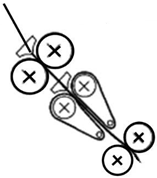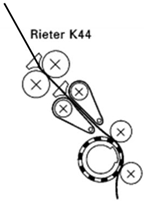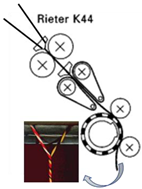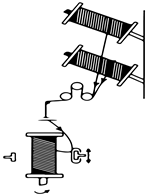Abstract
Stainless-steel fibre hybrid spun yarns are becoming increasingly popular due to their wide range of applications. In this aspect, the cost-effective and scalable processing of such yarns is highly important. Stainless-steel staple fibres are relatively heavier and weaker compared to conventional textile fibres. As a result, the staple spinning processing of these fibres showing higher tensile strength and productivity both at the same time is quite challenging. In this manuscript, we explored a number of spinning techniques to find the optimised method of producing low-twist and high-strength stainless-steel fibre hybrid spun yarns offering the advantage of both quality and productivity. Conventional ring spinning, folding and twisting, and advanced ring spinning techniques (ARSTs) such as pneumatic compact ring spinning and pneumatic compact SIRO spinning were employed in this study. Additionally, the plain and SIRO yarns were produced in two forms using the compact spinning method, one with pneumatic suction active (compact plain, compact SIRO) and other with pneumatic suction inactive (noncompact plain, noncompact SIRO). The tensile properties of yarns were tested and analysed. The results reveal that the tensile properties of conventional ring-spun and plied yarns can be enhanced to some extent by increasing the twist coefficient (TC) and the number of yarn plies, respectively. In contrast, by finding optimised spinning parameters, a substantially higher tensile strength (up to 16%) of yarns, produced at ARSTs, was observed even at the minimum level of TC used in experiments. The findings of the study are extremely valuable in terms of scaling up the production of high-quality metallic fibre hybrid spun yarns at a higher productivity level.
1. Introduction
Stainless-steel fibre hybrid spun yarns are becoming increasingly popular due to their wide range of applications. In this aspect, the cost-effective and scalable processing of such yarns is highly important. The processing of metallic fibre yarns has widely been reported because of their numerous applications in technical, industrial, multifunctional, health care, fashion and artistic textiles [1,2,3,4]. Among numerous types of such yarns, the metallic fibre hybrid spun yarns are preferred because of their novel combination of mechanical, comfort and functional properties, especially desired in wearable applications [5,6,7,8,9]. The spun hybrid yarns, carrying metallic fibres are gaining a lot of interest owing to their myriad potential applications such as, electrostatic discharge protection, electromagnetic interference shielding, flexible strain sensors and actuators, wearable electronics, as well as technical, functional, and smart textiles [10,11,12,13,14,15]. Among various types of metallic fibres, the use of copper wire, stainless-steel wire, and stainless-steel staples fibres (SSSF) have been widely reported in the literature [16,17]. However, in contrast to copper wire and stainless-steel wire, the staple fibre hybrid yarns constituting SSSF are more flexible, soft, and easy to integrate into fabric by well-established fabric manufacturing techniques such as weaving and knitting [18,19,20].
There are numerous ways of incorporating metallic fibres into conventional textile fibres to produce metallic fibre hybrid spun yarns [21,22]. The manufacturing of SSSF hybrid spun yarn is mostly carried out either by advanced friction spinning technique or conventional ring spinning process. The use of friction spinning machines (DREF II and III) was reported to produce the core-sheath yarns of stainless-steel wire, polyester fibres and SSSF for the construction of electromagnetic and electrostatic protective textiles, but without narrating the tensile properties of yarn produced [23,24]. The use of conventional ring spinning for the processing of SSSF hybrid spun yarns have been reported by some researchers. Cheng, K. B used polyester and stainless-steel fibres blended ring-spun yarns to study the electromagnetic shielding properties of knitted fabrics [25]. Similarly, other researchers have revealed the development of hybrid ring-spun yarn composed of polypropylene and SSSF to analyse the physical, mechanical and electrical properties of these yarns [26,27]. Shahzad et.al, reported the use of the conventional ring spinning technique for the production and electro-mechanical characterization of SSSF hybrid spun yarns [3,18].
From the state-of-the-art review, it can be concluded that the scholars have discussed mostly the properties and applications of metallic fibre yarns and less work has been carried out on the method of their fabrication, especially low twist and high strength, thus an energy-efficient and cost-effective way of processing. In the processing of staple spinning, with the right choice of spinning technique and optimised process parameters, better yarn quality at a higher production rate can be achieved economically. Strategies favouring the relatively lower production speeds, less wastage of materials and lower ends down rates, can bring down the cost of maintenance as well as electrical energy consumption. Consequently, an economical and sustainable method of yarn production can be approached. The twist of yarn is the most crucial processing parameter, governing the production rate, quality of yarn and cost of production. Keeping in view, this work is primarily focussed on investigating the process parameters of various spinning methods to explore the low twist, high strength and bulk production of stainless-steel fibre hybrid spun yarns in a cost-effective and sustainable approach. More specifically, the study aimed at the processing of MFHSYs composed of polyester and stainless-steel staple fibres (PET/SSSF) on conventional (ring spinning and ring twister machines) and ARSTs (Compact and SIRO ring spinning systems). The novel blend of PET/SSSF is especially considered due to its unusual combination of both textile and functional characteristics in a variety of premium products applications.
2. Materials and Methods
Polyester staple fibres were provided from ICI Pakistan. The bundle drawn SSSF, produced from a special grade stainless steel (316L) were sourced from Bekaert, Belgium in the sliver form (sliver weight 5 ktex). These SSSF exhibit sufficient mechanical strength and flexibility intended for textile processing. The physical characteristics of both fibres are given in Table 1.

Table 1.
Physical characteristics of fibres.
- Processing of materials
The polyester fibres were processed in the blow room (Toyota-Ohara-Hergeth) and carding (Howa-CM80) to produce the carded sliver. The blending of polyester and stainless-steel fibre slivers was carried out on the draw frame (Toyoda DHY 500C). To assure the uniform mixing of heterogeneous fibres, three recurrent blending passages were given on the draw frame. The slivers were then processed on a simplex frame (Toyota FL16) to produce the roving. Roving made of 80% polyester and 20% stainless steel was then used to produce the yarns. The process flow chart of the numerous yarns produced is shown in Figure 1.
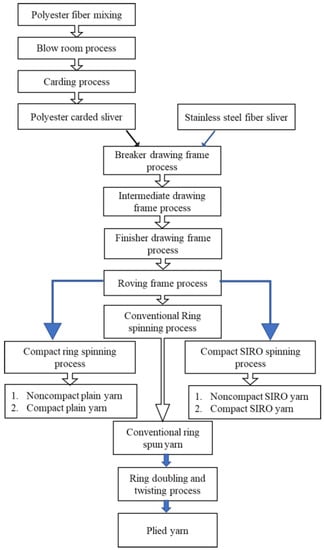
Figure 1.
Schematic process flow of yarns produced.
Since the tensile properties of yarns are considered to be varied by the spinning technique and processing parameters, the yarns were produced on both the conventional and ARSTs to realize their comparative advantages. For conventional techniques, conventional ring spinning (Toyota RY5) and ring doubling and twisting were employed. While among ARSTs, compact spinning (Rieter K44) and SIRO compact spinning (Rieter K44 additionally equipped with SIRO yarn device) were used. A brief description of these spinning techniques is given in Table 2, for a better understanding of major differences between them.

Table 2.
Brief description of spinning techniques.
- Experimental plan
The yarns were produced by four different spinning techniques according to the scheme as given in Table 3. The yarn samples PS1 to PS3 were produced at three distinct levels of TC, i.e., 2.3, 2.8 and 3.3. The PS4 and PS5 correspond to the yarn count Ne 20s and Ne 30s, respectively, both procured at TC 3.3. PS6 (two-ply, Ne 20D) and PS7 (three-ply, Ne 30T) yarns were developed on a ring twister machine from Ne 20s and Ne 30s yarns, respectively. The resultant count of plied yarns was supposed to be Ne 10s to compare the results of similar yarn counts from various methods. The folding and twisting of component yarns were performed simultaneously on the ring twister with the direction of a folding twist (S) opposite to that of a single yarn twist (Z). The folding twist and spindle speed were set as 8.5 turns per inch and 6000 rpm, respectively. The detailed parameters of conventional ring spinning and ARSTs are given in Table 4.

Table 3.
Design of experimental plan.

Table 4.
Process parameters of conventional ring spinning and ARSTs.
All the yarn samples were conditioned before testing, according to ASTM D 1776 [28]. The tensile properties were tested using Uster Tensorapid, according to ASTM D2256 [29]. The hairiness S3 (The number of fibres longer than 3 mm) of compact yarns were tested using the Zweigle Hairiness Tester, according to ASTM D5647 [30].
Processing of ARSTs Hybrid Spun Yarns
To produce yarns from PS8 to PS11 on ARSTs, the rovings were processed on a Rieter compact K-44, a ring spinning machine with and without SIRO attachment. To avoid the differences of yarn path and spinning geometry between the Rieter compact and conventional ring spinning frames, the noncompact yarns were also produced on the same K-44 ring spinning machine by keeping the pneumatic suction inactive and active for noncompact and compact yarns, respectively. For SIRO yarns, two rovings were fed side by side on one spinning position, while for the plain yarns, single roving was fed at individual spinning position. In addition, the following essential aspects were considered while optimising the processing of the MFHSYs on ARSTs.
- For coarse counts, a suction insert with the straight suction path was used to achieve a better suction effect.
- The air-guide elements with dimensions of 52 mm/0.5 mm/2.0 mm were used.
- The slow processing speeds were preferred to ensure controlled drafting and smooth running of fibres.
- The relative humidity was set higher to diminish the effect of static charges and improve the strength of roving.
- The perforated suction drums and suction inserts were cleaned before processing.
- For the production of compact yarns with better tensile strength, apart from pneumatic compaction, the yarn tension was also increased by increasing the traveller number (T.N). Since a traveller is an essential element of imparting twist and winding of yarn on the cop, it is important to note that with an increase in T.N, the traveller weight is also increased. The higher traveller weight results in a greater frictional coefficient between ring and traveller and consequently, a higher yarn tension to a certain level can produce better yarn strength [31]. According to the Bracker short-staple manual, the respective traveller weight of T.N 8 and T.N 14, employed in this study, is about 125 mg and 250 mg, respectively [32].
- While yarn manufacturing at a lower TC, a heavier traveller was required to adjust the traveller lag with the front roller delivery rate for the proper winding of yarn.
3. Results and Discussion
The tensile properties are generally described by the two well-known parameters of tenacity and elongation. Both of which are crucial to the performance of yarn not only in the downstream processes but also in the service life of a product. The twist is essential to bind the staple fibres in the body of a spun yarn. The twist level in a yarn is usually expressed as turns per inch (TPI) and determined by the relationship of yarn count (Ne) and twist coefficient (TC) as given in Equation (1).
3.1. Effect of the Twist on Tensile Properties of Yarns
The tensile properties of MFHSYs are discussed in four sections corresponding to the objectives of the experimental design (Table 3). The tensile properties of MFHSYs from PS1 to PS3 are shown in Figure 2. The tenacity and elongation at the break of yarns are found to increase with the increase in TC. Under the optimum level of TC, this proportional increase in tensile properties is generally predictable. However, this predictable behaviour is only true within a specific range of defined parameters, distinctive to the material, composition, yarn count and processing parameters. What stands out in this figure is the stepwise decreasing trend of the relative increase in tenacity. It can be seen that, for the first step of increase in TC from 2.3 to 2.8, the tenacity is increased from 24.41 cN tex−1 to 25.51 cN tex−1 (about 4.51% improvement is realised). While for a further rise in TC from 2.8 to 3.3, there is only a small rise of tenacity about 2.3% reaching maximum of 26.09 cN tex−1. This behaviour may indicate that as TC rises over 3.3, the further increase in tenacity could be unpredictable. The regression analysis was used to predict the extent of the relationship between the dependent variable of tensile properties and the independent variable of TC, and the results are given in Table 5. Though the positive sign of slope coefficient and fairly higher value R2 in regression equation revealed a strong positive interaction of tensile properties and TC. However, the results are based on only three set points. The increase in tensile properties of yarns with increasing TC could be attributed to the improved packing density and, consequently, increase in resistance to the slippage of fibres in the yarn [33,34,35]. The increase in the tenacity with increasing TC occurs only up to a certain level of TC, called optimum TC [36,37].
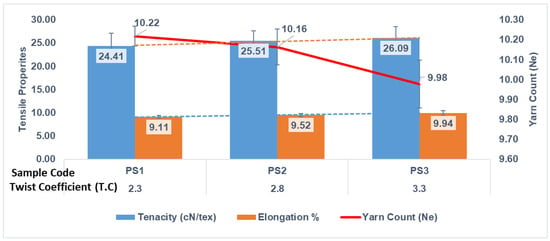
Figure 2.
Effect of TC on tensile properties of conventional ring-spun MFHSYs.

Table 5.
Linear regression analysis of tensile properties for ring-spun and plied MFHSYs.
According to Equation (1), the greater the value of TC, the greater the twist level in the yarn for a fixed yarn count will be. Consequently, the twist angle (helix angle of surface fibres around the yarn axis) of fibres is also increased, thus producing a contraction in yarn length, commonly designated as twist contraction [38,39]. This twist contraction is further responsible for building a more compact yarn structure with a somewhat coarser yarn count (Ne), as seen from a line chart in Figure 2, where yarn count has decreased stepwise from 10.22 s Ne to 10.16 s Ne and 9.98 s Ne with an increase in TC.
In addition, it should be noted that the actual TPI of yarn is also related to the spindle speed and front roller delivery of the ring spinning machine by the following Equation (2).
where:
- Ns: Spindle speed (rpm);
- Vd: Front roller delivery rate (inches/min).
From Equations (1) and (2), the yarn delivery rate can be described as per Equation (3).
It can be seen that for a given yarn count, the yarn delivery rate or productivity is inversely related to the yarn TC. Here, it is also pertinent to mention that though the higher tensile properties can be attained on a conventional ring spinning system by increasing TC, the yarn production rate will affect adversely. Nevertheless, for a cost-effective industrial-scale production process, a higher production rate is increasingly preferred once the acceptable level of yarn tenacity has been achieved [40,41].
Moreover, the elongation at break is also observed to increase with the increase in TC. This might happen due to the rise in the twisting angle of fibres in the yarn and the subsequent twist contraction corresponding to an increase in the TC [38,42]. Similar to the coils of a spring, the fibre turns per unit length of spun yarn are increased at the higher TC. Therefore, a larger number of turns per unit length can result in higher extensibility of yarns under a certain tensile load [43].
3.2. Effect of Yarn Count (Ne) on Tensile Properties
The tensile properties of MFHSYs produced at different yarn counts are shown in Figure 3, where PS3, PS4 and PS5 represent yarn counts Ne 10 s, Ne 20 s and Ne 30 s, respectively. Whereby the Ne 10 s represents a coarser yarn count while Ne 30s indicates a relatively finer yarn count. All three yarn counts were produced at a fixed level of TC, i.e., 3.3 to keep an identical angle of twist in the yarn [44]. The decrease in tenacity and elongation with a stepwise increase in yarn count can be assigned to the decrease in the total number of fibres constituting the yarn [45]. Since SSSF is about six times heavier (8.0 g·cm−3) than that of polyester fibre (1.34 g·cm−3), which means that one low tenacity SSSF fibre (19 cN tex−1) with minor elongation (1.0%) can replace about three high tenacity polyester fibres (46 cN tex−1) with superior elongation (32%) in the yarn. In addition, the total number of fibres in the yarn cross-section also tend to reduce with increasing yarn fineness (greater value of Ne yarn count) [46,47]. As a result, in a finer yarn with an overall smaller number of fibres in the yarn cross-section, the replacement of polyester fibres by SSSF will reduce the yarn strength and elongation. While in coarser yarn count, due to higher frictional coefficient o SSSF and a greater number of total fibres in the yarn cross-section, a stronger inter-fibre cohesion evolves in the yarn [48]. Thereby, for coarse yarns the resistance to slippage among the fibres in the yarn is increased under a tensile load producing a stronger yarn with higher elongation [49]. However, at a higher yarn count, the contribution of TC towards tensile properties of yarn has appeared to decrease with a stepwise increase in yarn count. Hence, at a higher yarn count, a further increase in TC beyond 3.3 can try to achieve even better tensile characteristics of the yarn.
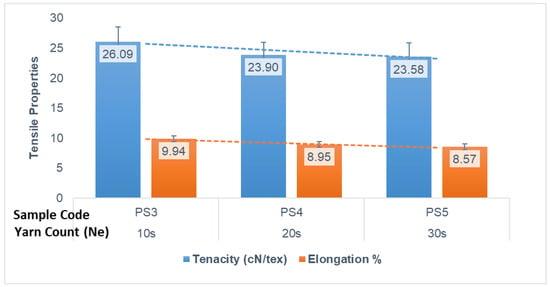
Figure 3.
Effect of yarn count on tensile properties of conventional ring-spun MFHSYs.
The regression equations for yarn count and tensile properties are given in Table 5, where the negative signs of slope coefficients confirm an inverse relationship of yarn count with tenacity and elongation. The R2 values for tenacity and elongation are 0.8439 and 0.931, respectively, reflecting a strong interaction of the parameters. However, a significant decrease in tenacity is observed from 26.09 cN tex−1 to 23.90 cN tex−1 for PS3 to PS4, which further declines by a small amount to 23.58 cN tex−1 for PS5. A relatively smaller value of R2 associated with tenacity also indicates that the gradual change in tenacity is not perfectly linear.
3.3. Effect of Ply Twisting on Tensile Properties of Plied Yarns
It can be seen from the results shown in Figure 4, that with ply twisting, the tenacity of yarn is improved while the elongation is reduced to some extent. This might occur due to the reason that the single yarns were produced with Z twist and then plied together with S twist. This opposite direction of folding twist decreases the twist of component single yarns to an extent corresponding to the amount of folding twist in plied yarns. The twisting angle of fibres in component yarns is also reduced with the reduction in Z twist, and helically arranged fibres could be oriented along the yarn axis. In this way, the contribution of fibre strength towards yarn strength is enhanced under an axial tensile load. The effective supplementary binding of superficial fibres (including hairiness) into the bulk of yarn by ply twisting may contribute positively towards the yarn tenacity. Additionally, the thick/thin places of spun yarns are even out during ply twisting, which may also be the cause of an increase in tenacity [50].
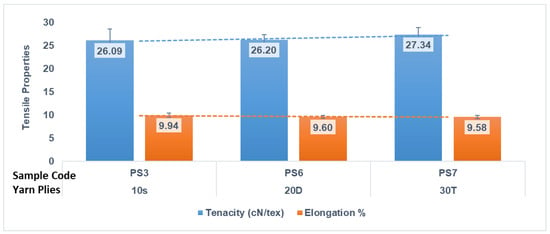
Figure 4.
Effect of yarn plying and twisting on tensile properties of MFHSYs.
On the other hand, the axial orientation of fibres in plied yarns along with the better binding of surface fibres in the yarn body may help to reduce the elongation of plied yarns [50]. The linear regression equations for the correlation of tenacity and elongation with plied yarns are given in Table 5. The positive signs of slope coefficient for tenacity and negative for elongation have confirmed their direct and inverse relationship, respectively, with ply twisting of spun yarn. The R2 values of tenacity and elongation are 0.8154 and 0.7915, respectively, which show that the relationship between tensile properties and ply twisting is good enough but not entirely linear.
3.4. Effect of ARSTs on Tensile Properties
The results of the tensile properties of noncompact plain (NCP), compact plain (CP), noncompact SIRO (NCS) and compact SIRO (CS) yarns are presented in Figure 5. It was surprising to observe that the NCP yarn showed unexpectedly higher tenacity than that of CP yarn produced even at the same machine and operating parameters. During the processing of NCP yarn on a K-44 machine with pneumatic compaction inactive, the edge fibres are not fully integrated into the yarn body, and some fibres may escape the twisting effect due to the wider width of drafted roving and consequently outflowing the spinning triangle. These escaped fibres are either wasted as a fly or attached disorderly in the yarn, as exposed in Figure 6, under PS8 NCP.
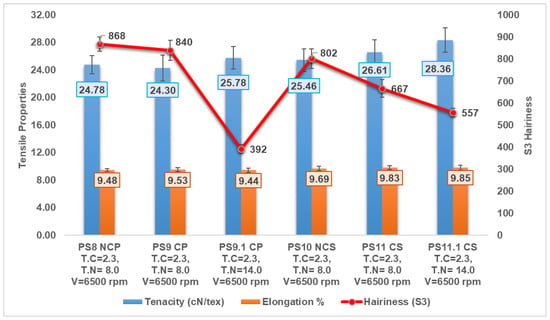
Figure 5.
Effect of ARSTs parameters on tensile properties and hairiness of yarns.
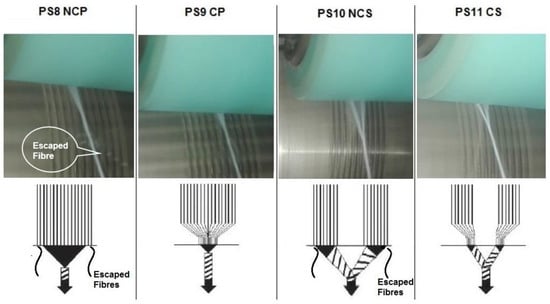
Figure 6.
Yarn formation zone of plain and SIRO, compact and noncompact yarns.
However, in CP yarn, the edge fibres are relatively more integrated and orderly arranged into the yarn body due to the unique attributes of the compact spinning system [51]. The compact yarns exhibit better packing density, compact structure and lower hairiness with improved fibre utilization [52]. Therefore, the tenacity of CP yarn should always be higher than that of NCP yarn. However, it was astonishing to note that despite all the constant operating parameters of spinning geometry, spindle speed, T.N. and TC, the tenacity of CP yarn was lower than that of NCP yarn. Although the elongation at break of CP yarn is somewhat better than that of NCP yarn. The tenacity might be lower due to a decrease in yarn tension (the force produced by the rotation of the traveller around the ring and dragging of yarn by winding cope through the traveller) during spinning, which should be high enough to increase the yarn tenacity and compact winding over the cope. The yarn tension is a crucial factor in improving the yarn tenacity since it affects the transmission of twist from the traveller to the nip line of front rollers with consequent firm gripping of fibres in the yarn body resulting from narrowing the width of the spinning triangle [31,53]. However, an optimum yarn tension is necessary to establish a smooth running of the process, less ends down rate, stable package density and better package density of the cop.
Other than yarn tension, the hairiness-S3 value of CP yarn is also very close to that of NCP yarn, which should be reduced significantly for the true compact structure of CP yarn. The yarn tension, which is directly related to the frictional drag of the traveller, represented by Equation (4), generally depends on fibre characteristics, spindle speed, traveller weight, ring diameter, yarn count and delivery rate of the spinning machine [54,55]. To increase the traveller’s weight, a traveller with a larger T.N is used. In this case, when T.N was increased from 8.0 to 14.0 with all other parameters kept constant, the tenacity of CP yarn was increased from 24.30 cN tex−1 to 25.78 cN tex−1. An increase in T.N caused an increase in yarn tension, which resulted in a significant decrease in hairiness-S3 value from 840 to 392, thus confirming the compact structure of CP yarn with firm gripping and better utilization of fibres in the yarn body.
where:
- F = Frictional drag of the traveller (N);
- µ = Coefficient of friction between the ring and traveller;
- M = Mass of the traveller (Kg);
- RR = Ring radius (m);
- Angular velocity of the traveller ( ;
- Nt = Traveller speed (rpm).
In the case of SIRO yarns, the tenacity and elongation at the break of compact SIRO (CS) yarn are better than that of noncompact SIRO (NCS) yarn. It was also interesting to note that with the sole increase in T.N from 8.0 to 14.0, while all other parameters being constant, the tenacity of CS yarn was increased from 26.61 cN tex−1 to 28.36 cN tex−1. This rise in tenacity could be attributed to the possible higher yarn tension and reduced yarn hairiness (S3 value dropped from 667 to 557 corresponding to T.N 8 and 14, respectively) caused by higher traveller weight of T.N 14. However, this decrease in yarn hairiness is not as significant as in the case of CP yarn produced with the same traveller mass. The better tenacity of SIRO yarn can be assigned to the following attributes of the SIRO yarn structure.
SIRO yarn is produced by feeding two rovings of similar count on one spinning position. A V-shaped geometry is formed at the yarn formation zone, as shown in Figure 6. The component strand of SIRO yarns before twisting into a resultant yarn, get a limited amount of pre-twist in a similar direction of final yarn twist. The insertion of a twist in a similar direction (i.e., Z/Z) facilitates the gripping of fibres in component strands prior to twisting into the SIRO yarn body. In this way, a certain binding of some edge fibres is also carried out in the component strands. The consolidated strands with a rather partial twist are then twisted around each other constituting the final yarn structure. This phenomenon leads to a better arrangement, gripping and utilization of fibres in the SIRO yarn as compared to conventional ring-spun yarn. Moreover, in SIRO yarn, a relatively axial arrangement of fibres is perceived in the yarn due to the consolidation of component strands before twisting into the final yarn [52]. This specific placement of fibres within the yarn could be decisive in improving the tensile properties of the resultant SIRO yarn.
In compact SIRO yarn the higher yarn tenacity may be attributed to the following reasons. Compared to the plain yarn formed by single roving, in the manufacturing of SIRO yarn, each roving receives almost two times a higher roller draft; thus, a two times finer yarn count is delivered from each roving. The number of fibres per cross-section decreases as the yarn count of component strands increases, and the influence of available pneumatic suction at the condensing zone may become stronger, resulting in a higher degree of compactness in the finer strands.
The compaction of finer component strands in the condensing zone facilitates the contraction of their spinning triangles in the yarn formation zone, as shown in Figure 6. Moreover, these compacted strands run together, preferably close to each other above the condensing zone. Hence, in the yarn formation zone, the V-shape of CS yarn becomes narrow as compared to the V-shape of NCS yarn. The V-shape for both CS and NCS yarns is shown in Figure 6. The narrow V-shape formed in CS yarn spinning facilitates additional compactness of fibre strands, less escape of edge fibres and more ordered arrangement of fibres in the yarn, all of which could contribute to greater fibre integration and yarn strength. Therefore, the tensile properties of CS yarn are superior to all the prepared samples, even at the lowest level of TC.
4. Conclusions
The study aimed to explore the right technique and process parameters for the collective benefit of yarn tensile properties and productivity of stainless-steel MFHSYs. It was observed that in the case of conventional ring-spun yarn, the tenacity tends to increase by increasing TC, but these changes were within the limits of error. Though the coefficient of regression was relatively high in this case; however, the line only passed through three experimental points! While, in the case of fine yarn produced at TC 3.3, the relative lower strength may indicate the necessity for a further increase in TC to achieve even better yarn strength. In addition, the yarn plying and twisting has also shown tremendous potential in improving the yarn strength from 26.09 cN tex−1 to 27.34 cN tex−1, but both the timelines and cost of production are compromised. On the other hand, in the case of value addition through compact and compact SIRO spinning, both superior tensile properties (tenacity from 25.78 cN tex−1 to 28.36 cN tex−1 and elongation from 9.44% to 9.85%) and better productivity can be achieved simultaneously even at the lower level of TC. The knowledge collected and presented in this study is expected to be valuable in the industrial-scale manufacturing and end use of metallic hybrid spun yarns with excellent quality and productivity.
Author Contributions
A.S., M.B.Q. and Z.A.: Conceptualised and designed the study. A.S. performed the experiments. M.B.Q. and Z.K. helped analysed and interpret the results. M.Q.K. and I.-S.K. reviewed, edited and provided the financial support for publication. The manuscript was written by contribution of all authors. All authors have read and agreed to the published version of the manuscript.
Funding
This research received no external funding.
Institutional Review Board Statement
Not applicable.
Informed Consent Statement
Not applicable.
Data Availability Statement
Not applicable.
Conflicts of Interest
All authors declare that they have no conflict of interest nor any affiliation with or involvement in any organisation or entity with any financial interest (such as honoraria; educational grants; participation in speakers’ bureaus; membership, employment, consultancies, stock ownership, or other equity interest; and expert testimony or patent-licensing arrangements), or non-financial interest (such as personal or professional relationships, affiliations, knowledge or beliefs) in the subject matter or materials discussed in this manuscript.
References
- Ali, Z.; Shahnawaz, M.; Qadir, M.B.; Khaliq, Z.; Afzal, A.; Shahzad, A. Development of Comfortable Fire Resistant Fabrics for Bed Sheets. In Proceedings of the International Conference on Innovation & Entrepreneurship in Textiles (IE-TEX-2018), Faisalabad, Pakistan, 6 March 2018. [Google Scholar]
- Alshukur, M.; Fotheringham, A. Structural Ratio of Multi-Thread Fancy Yarn: Interaction Effect of Both the Number of Wraps and the Overfeed Ratio on Fancy Bouclé Yarn Structure. J. Nat. Fibers 2019, 18, 1570–1579. [Google Scholar] [CrossRef]
- Asghar, A.; Ahmad, M.; Yahya, M.; Ali, M.; Ab Aziz, A.; Abd Rahman, N.; Kashif, M. An Alternative Approach to Design Conductive Hybrid Cover Yarns for Efficient Electromagnetic Shielding Fabrics. J. Ind. Text. 2018, 48, 38–57. [Google Scholar] [CrossRef]
- Bansode, A.S. Spinning Geometry of Ring Spinning Machine. 2019. Available online: http://www.textilevaluechain.com/index.php/article/technical/item/88-spinning-geometry-of-ring-spinning-machine (accessed on 20 January 2022).
- Bonaldi, R.R. 12a—Electronics Used in High-Performance Apparel—Part 1/2. In High-Performance Apparel; McLoughlin, J., Sabir, T., Eds.; Woodhead Publishing: Cambridge, UK, 2018; pp. 245–284. [Google Scholar]
- Bracker Short Staple Manual. Available online: https://www.bracker.ch/fileadmin/bracker/products/EN/Brcker_Manual_for_Short_Staple_Spinning/manualshortstaplespinning.pdf (accessed on 20 January 2022).
- Broughton, R.M.; Mogahzy, Y.E.; Hall, D.M. Mechanism of Yarn Failure. Text. Res. J. 1992, 62, 131–134. [Google Scholar] [CrossRef]
- Chen, H.C.; Lin, J.H.; Lee, K.C. Electromagnetic Shielding Effectiveness of Copper/Stainless Steel/Polyamide Fiber Co-Woven-Knitted Fabric Reinforced Polypropylene Composites. J. Reinf. Plast. Compos. 2007, 27, 187–204. [Google Scholar] [CrossRef]
- Cheng, K.B. Production and Electromagnetic Shielding Effectiveness of the Knitted Stainless Steel/Polyester Fabrics. J. Text. Eng. 2000, 46, 42–52. [Google Scholar] [CrossRef][Green Version]
- Cheng, K.B.; Lee, M.L.; Ramakrishna, S.; Ueng, T.H. Electromagnetic Shielding Effectiveness of Stainless Steel/Polyester Woven Fabrics. Text. Res. J. 2001, 71, 42–49. [Google Scholar] [CrossRef]
- Cork, C.R.; Cooke, W.D.; Wild, J.P. The Use of Image Analysis to Determine Yarn Twist Level in Archaeological Textiles. Archaeometry 1996, 38, 337–345. [Google Scholar] [CrossRef]
- Astm D1776/D1776m-16; Standard Practice for Conditioning and Testing Textiles. Astm International: West Conshohocken, PA, USA, 2016.
- Astm D2256/D2256m-10; Standard Test Method for Tensile Properties of Yarns by the Single-Strand Method. Astm International: West Conshohocken, PA, USA, 2015.
- Astm D5647-07; Standard Guide for Measuring Hairiness of Yarns by the Photo-Electric Apparatus. Astm International: West Conshohocken, PA, USA, 2018.
- De Bar, A.E. End-Breakage in Ring Spinning. J. Text. Inst. Trans. 1959, 50, T284–T293. [Google Scholar] [CrossRef]
- Donciu, C. Core Conductive Yarn Based Integral Knitted Esd Garments Part I. Metallic Core Conductive Yarns Investigation. Adv. Mater. Res. 2013, 772, 467–473. [Google Scholar] [CrossRef]
- Effect of Twist on Yarn Strength|Yarn Twist|Twisted Yarn. 2018. Available online: http://articletrade.blogspoTCom/2014/04/effect-of-twist-on-yarn-strength-yarn.html (accessed on 20 January 2022).
- Erdumlu, N.; Saricam, C. Electromagnetic Shielding Effectiveness of Woven Fabrics Containing Cotton/Metal-Wrapped Hybrid Yarns. J. Ind. Text. 2016, 46, 1084–1103. [Google Scholar] [CrossRef]
- Huh, Y.; Kim, Y.R.; Oxenham, W. Analyzing Structural and Physical Properties of Ring, Rotor, and Friction Spun Yarns. Text. Res. J. 2002, 72, 156–163. [Google Scholar] [CrossRef]
- Hussain, U.; Shafqat, A.; Iqbal, M.; Hussain, T.; Zahra, N.; Sarwar, A.; Ahmed, F. Effect of Spinning Variables on Packing Density of Cotton Yarn. Indian J. Fibre Text. Res. 2014, 39, 434–436. [Google Scholar]
- Khanum, R.; Ahmed, F.; Mahabubuzzaman, A.; Ehsan, M.; Asaduzzaman, M. Consequence of Twist on Yarn Properties in Textiles. J. Innov. Dev. Strategy 2011, 5, 22–27. [Google Scholar]
- Kumar, R.S. Process Management in Spinning, 1st ed.; CRC Press–Taylor and Francis: Boca Raton, FL, USA, 2014. [Google Scholar]
- Landstreet, C.B. An Experimental Study of Spinning Tension and Its Relation to Fiber Properties and End Breakage. Master’s Thesis, University of Tennessee, Knoxville, TN, USA, 1963; p. 584661. [Google Scholar]
- Lawrence, C.A. Fundamentals of Spun Yarn Technology; CRC Press: Washington, DC, USA, 2003. [Google Scholar]
- Lewis, W.S. Physical Testing of Cotton Yarns; U.S. Government Printing Office: Washington, DC, USA, 1913.
- Li, Q.; Wang, J.J.; Hurren, C.J. A Study on Wicking in Natural Staple Yarns. J. Nat. Fibers 2017, 14, 400–409. [Google Scholar] [CrossRef]
- Lord, P.R. 7—Short-Staple Spinning. In Handbook of Yarn Production; Lord, P.R., Ed.; Woodhead Publishing: Cambridge, UK, 2003; pp. 168–204. [Google Scholar]
- Lorenz, R.R.C.; Howard, B. Yarn-Twisting. Text. Prog. 1987, 16, 1–89. [Google Scholar] [CrossRef]
- Lou, C.-W.; He, C.-H.; Lin, J.-H. Manufacturing Techniques and Property Evaluations of Conductive Elastic Knits. J. Ind. Text. 2019, 49, 503–533. [Google Scholar] [CrossRef]
- Miah, L.; Sharmin, N.; Yasmin, J. Impact of Spindle Speed and Traveler Weight on the Tensile Properties of Yarn Explicitly the Yarn Tenacity and Elongation at Break. Int. J. Innov. Sci. 2019, 6, 1–5. [Google Scholar]
- Ning, P. Development of a Constitutive Theory for Short Fiber Yarns Part II: Mechanics of Staple Yarn with Slippage Effect. Text. Res. J. 1993, 63, 504–514. [Google Scholar] [CrossRef]
- Pan, N. Prediction of Statistical Strengths of Twisted Fibre Structures. J. Mater. Sci. 1993, 28, 6107–6114. [Google Scholar] [CrossRef]
- Pan, N.; Postle, R. Strengths of Twisted Blend Fibrous Structures: Theoretical Prediction of the Hybrid Effects. J. Text. Inst. 1995, 86, 559–580. [Google Scholar] [CrossRef]
- Pei, Z.; Zhang, Y.; Chen, G. A Core-Spun Yarn Containing a Metal Wire Manufactured by a Modified Vortex Spinning System. Text. Res. J. 2017, 89, 113–118. [Google Scholar] [CrossRef]
- Perumalraj, R.; Dasaradhan, B.S.; Nalankilli, G. Copper, Stainless Steel, Glass Core Yarn, and Ply Yarn Woven Fabric Composite Materials Properties. J. Reinf. Plast. Compos. 2010, 29, 3074–3082. [Google Scholar] [CrossRef]
- Qadir, B.; Hussain, T.; Malik, M. Effect of Elastane Denier and Draft Ratio of Core-Spun Cotton Weft Yarns on the Mechanical Properties of Woven Fabrics. J. Eng. Fibers Fabr. 2014, 9, 23–31. [Google Scholar] [CrossRef]
- Qadir, M.B.; Umer, D.; Shahzad, A. Development of Multifunctional Yarns and Fabrics for Interactive Textiles. In Proceedings of the 20th International Conference on Wearable Computers and Innovative Fashion, Montreal, QC, Canada, 24 May 2018. [Google Scholar]
- Regar, M.L.; Sinha, S.K.; Chattopadhyay, R. Fibre Distribution and Packing in Eli-Twist, Siro and Ring Spun Tfo Yarn. J. Inst. Eng. Ser. E 2018, 99, 177–186. [Google Scholar] [CrossRef]
- Rieter. Twist and Strength. 2018. Available online: https://www.rieter.com/cz/rikipedia/articles/technology-ofshort-staple-spinning/yarn-formation/imparting-strength/true-twist-with-reference-to-ring-spun-yarn/twist-and-strength/ (accessed on 20 January 2022).
- Šafářová, V.; Militký, J. A Study of Electrical Conductivity of Hybrid Yarns Containing Metal Fibers. J. Mater. Sci. Eng. B 2012, 2, 197–202. [Google Scholar]
- Sahito, I.A.; Sun, K.C.; Arbab, A.A.; Qadir, M.B.; Mengal, N.; Memon, A.A.; Jeong, S.H. Fabrication of Flexible and Conductive Cotton Fabric Electrode. In Proceedings of the Paper presented at the 1st International Conference on Technical Textiles (ICTT-2017), Faisalabad, Pakistan, 9 November 2017. [Google Scholar]
- Sancak, E.; Akalin, M.; Usta, İ.; Yuksek, M.; Özen, M.S. The Effects of Fabric and Conductive Wire Properties on Electromagnetic Shielding Effectiveness and Surface Resistivity of Interlock Knitted Fabrics. Fibers Polym. 2018, 19, 843–853. [Google Scholar] [CrossRef]
- Shahzad, A.; Ahmad, N.; Ali, Z.; Afzal, A.; Qadir, M.B.; Khaliq, Z.; Khan, M.Q. Statistical Analysis of Yarn to Metal Frictional Coefficient of Cotton Spun Yarn Using Taguchi Design of Experiment. J. Strain Anal. Eng. Des. 2018, 53, 485–493. [Google Scholar] [CrossRef]
- Shahzad, A.; Ali, Z.; Ali, U.; Khaliq, Z.; Zubair, M.; Kim, I.S.; Qadir, M.B. Development and Characterization of Conductive Ring Spun Hybrid Yarns. J. Text. Inst. 2019, 110, 141–150. [Google Scholar] [CrossRef]
- Shahzad, A.; Rasheed, A.; Khaliq, Z.; Qadir, M.B.; Khan, M.Q.; Hamdani, S.T.A.; Kim, I.S. Processing of Metallic Fiber Hybrid Spun Yarns for Better Electrical Conductivity. Mater. Manuf. Process. 2019, 34, 1008–1015. [Google Scholar] [CrossRef]
- ISO 17202:2002; Textiles—Determination of Twist in Single Spun Yarns. Untwist/Retwist Method. B S I Standards: London, UK, 2002.
- Sun, Y.C.; Cheng, Z. Property Analysis of Stainless Steel Fiber (Yarn) and Its Effect on Knitting Process. Adv. Mater. Res. 2014, 1053, 93–96. [Google Scholar] [CrossRef]
- Thilagavathi, G.; Karthik, T. Process Control and Yarn Quality in Spinning; Woodhead Publishing: New Delhi, India, 2015. [Google Scholar]
- Thilagavathi, G.; Karthik, T. Process Control and Yarn Quality in Spinning; WPI: New Delhi, India, 2016. [Google Scholar]
- Tunák, M.; Tunáková, V.; Schindler, M.; Procházka, J. Spatial Arrangement of Stainless Steel Fibers within Hybrid Yarns Designed for Electromagnetic Shielding. Text. Res. J. 2018, 89, 2019–2030. [Google Scholar] [CrossRef]
- Ueng, T.H.; Cheng, K.B. Friction Core-Spun Yarns for Electrical Properties of Woven Fabrics. Compos. Part A Appl. Sci. Manuf. 2001, 32, 1491–1496. [Google Scholar] [CrossRef]
- Wang, D.; Li, D.; Zhao, M.; Xu, Y.; Wei, Q. Multifunctional Wearable Smart Device Based on Conductive Reduced Graphene Oxide/Polyester Fabric. Appl. Surf. Sci. 2018, 454, 218–226. [Google Scholar] [CrossRef]
- Xie, J.; Gordon, S.; Long, H.; Miao, M. Electrical Percolation of Fibre Mixtures. Appl. Phys. A 2015, 121, 589–595. [Google Scholar] [CrossRef]
- Xie, J.; Gordon, S.; Long, H.; Miao, M. Twist Requirement for Blended Yarns. J. Text. Inst. 2017, 108, 852–855. [Google Scholar] [CrossRef]
- Yang, Y.; Wang, J.; Liu, Z.; Wang, Z. A New Study on the Influencing Factors and Mechanism of Shielding Effectiveness of Woven Fabrics Containing Stainless Steel Fibers. J. Ind. Text. 2019, 56, 830–846. [Google Scholar] [CrossRef]
Publisher’s Note: MDPI stays neutral with regard to jurisdictional claims in published maps and institutional affiliations. |
© 2022 by the authors. Licensee MDPI, Basel, Switzerland. This article is an open access article distributed under the terms and conditions of the Creative Commons Attribution (CC BY) license (https://creativecommons.org/licenses/by/4.0/).
